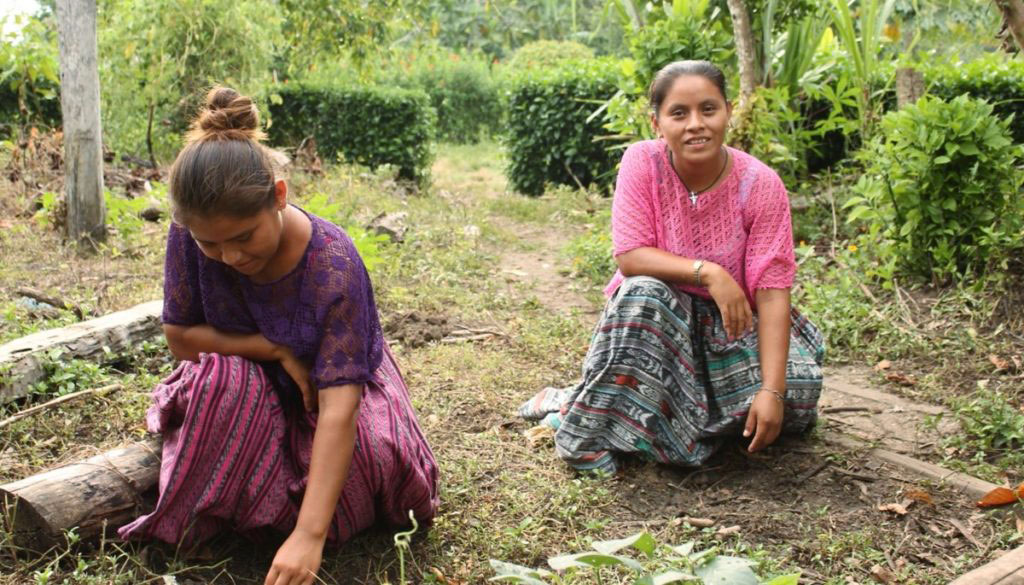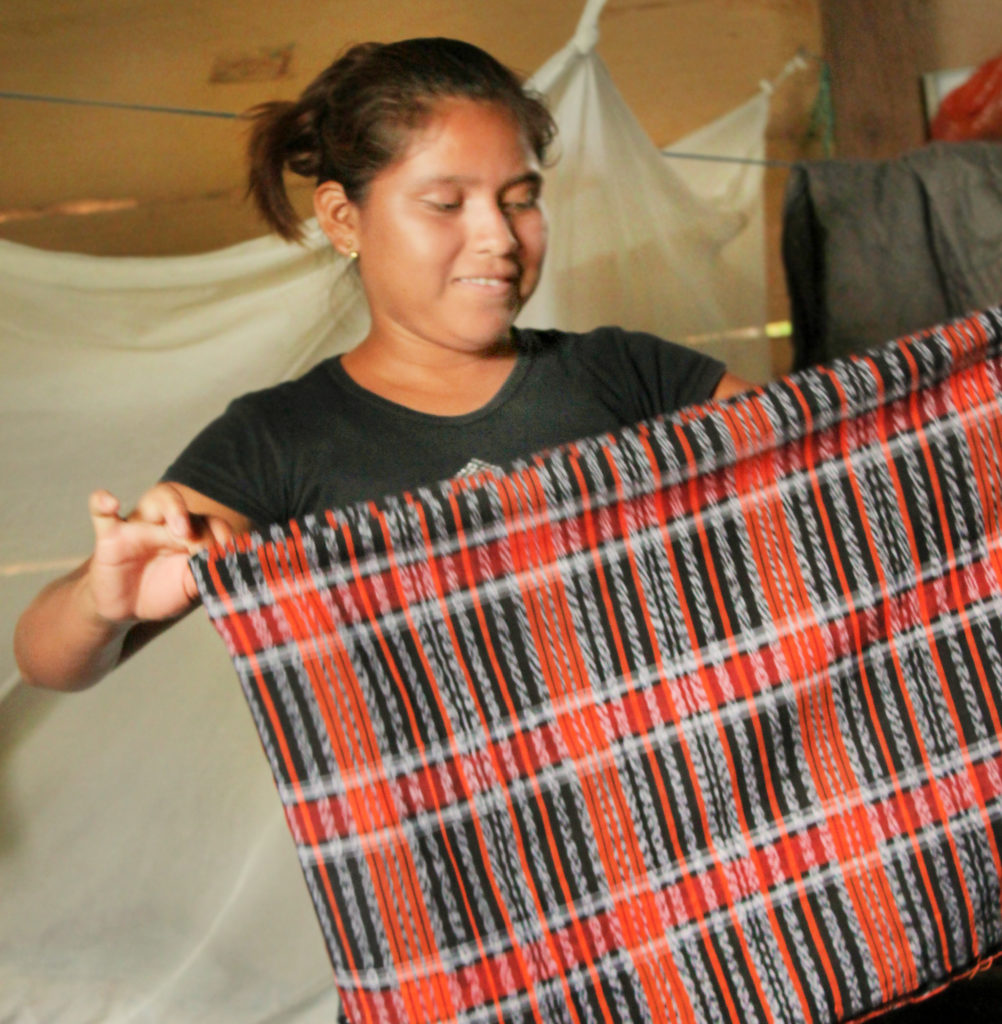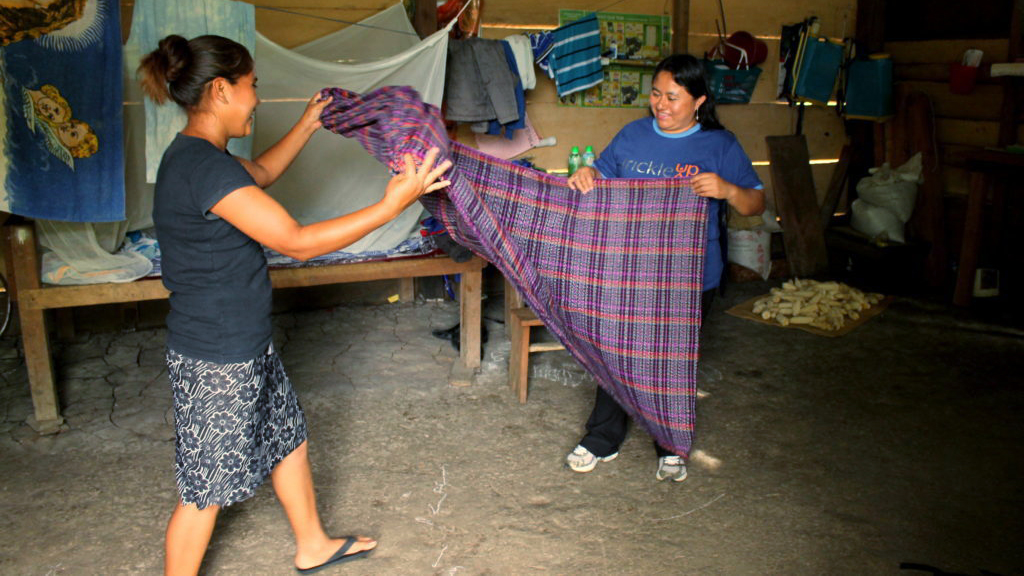14-year-old Mirna Lo Ixcal lives in a small house with the 7 other members of her family – her parents, four brothers, and an older sister. Her father manages their family plot planting corn and beans while her mother takes care of the housework.
Often, their whole family will work clearing the land, weeding, fertilizing, and harvesting crops. Their corn crop was only enough to feed their family 4 months out of the year. For additional income, her father and brothers worked on the nearby palm plantation. In some seasons, their income wasn’t sufficient to feed the family or address their health needs. When necessary, they ask for products on credit from local store owners and pay them back when some money comes in. In addition to the Guatemalan staples of corn and beans, Mirna’s family also consumes tortillas, rice, vegetables, local herbs like chayote, and eggs and meat when they can.
Mirna stopped going to school after finishing third grade in 2014. Now her days are dedicated to household chores like sweeping, cooking, and washing dishes, as well as the helping out on her family’s farm.
Mirna and her sister, Sandra Monica, were selected to participate in Trickle Up’s program because of their family’s extreme conditions of poverty. Mirna is a proactive member of the Flor de Santa Cruz savings group and is collaborative and helpful with others in the group. Because of these qualities, she was chosen as one of the group’s two leaders who are responsible for motivating their peers and providing peer support regarding the sexual and reproductive health trainings.

Before beginning her small business, Mirna participated in trainings where she learned to calculate costs and profits, and how to engage with customers – especially to be patient when they don’t buy her products. Mirna started a business buying and selling corte, the typical skirt worn by Mayan Q’eqchi women.
She decided on this business after her aunts told her the price of a dozen cortes and the possible profits from this type of business. With her seed capital grant of $75, she bought six cortes in Ixcán, the municipal capital, and began selling them in her own community and in the neighboring villages of San Marcos and Las Promesas.
She quickly realized that in buying in bulk, she was unable to select the colors and designs she thought her customers would buy. Nevertheless, Mirna’s business remains profitable, earning her $2.50 to $3 for each corte. After selling the first batch, she purchased more cortes and began to diversify her stock with other types of products. For example, her customers asked for bras, so she added them to her inventory. She asks her customers what kind of products they want, and in what colors, in order to match supply to demand.
In the second quarter after starting her business, Mirna had made $42 in profits, which she used to save, pay for health expenses, buy her own clothes, and invest back into her business. Her coach recommended that she improve her financial records so as to more accurately capture her expenses and income.

She has organized with other young women from her savings group to go house to house to sell together one day a week. They each offer different products for sale, complementing each other. If Mirna can’t go one week, her sister Sandra will go out and sell the cortes.
Mirna is the president of the Flor de Santa Cruz savings group; she took on the role after the previous president stepped down. Mirna says that she likes the savings group because they are saving money and eventually they will be able to grow their businesses with investments from their savings. Since they began saving before participants received their seed capital, Mirna had only been saving the required minimum at each meeting. Even so, less than a year, Mirna already had $31 in savings. Moreover, Mirna took loans (usually of just $12.50) from the group to buy more cortes for her business or to help her family cover the cost of food.
Mirna decided to diversify her products. In addition to skirts, she also started selling clothes for children and adults, including güipiles (a typical Mayan blouse), shirts, bras, and more.
In the third quarter, she managed to double her profits compared to the second quarter, going from $42 to $139 in accumulated profits. Now she feels confident about her future prospects. She tells us, “In previous months when I sold, I had resources and could support others who came to me to borrow money, which they paid back.”
During the lean season, Mirna stopped her business selling clothes because she knew her clients didn’t have the resources to buy from her. However, with the corn harvest approaching, the local economy will re-energize, and Mirna can start selling her products again.
She works hard to maintain and strengthen her business and increase her income. She reflects on the intergenerational differences in opportunities between her and her mother and the advantages she has because of the Trickle Up program: “My mom was married at age 15, no one told her about [women’s periods], she didn’t study, she didn’t go out to sell, while I have not been married yet.” Mirna is happy to have the ability to earn a living and save money. At her age, her mother could neither earn nor save.
Mirna manages the resources of her business herself and sometimes contributes her earnings towards household expenses like supporting the family during the lean season by buying food. She always allocates some money to buy more products to sell based on customer demand, and she bought herself a new güipile, two chickens, two ducks, and a pig.
After the first year of the savings group, Mirna received $35 and her sister Sandra Monica $53 from their savings and accrued interest. The sisters decided to continue in the savings group and together they’ve already saved $18 in just three months. Mirna used her savings for both work and play: she went to the fair in Ixcán, where she won several baskets and basins in a lottery. When she got back, she sold these assets to buy a gift for her mother and clothes for herself. Both she and her sister have taken loans in the savings group to invest in buying products for their business.
Mirna says that, through the project, “I learned what the risks are if I marry and get pregnant at an early age, and the responsibility that implies. Now is not the right age.” In addition, she tells us she has learned more about sales and no longer feels embarrassment or shame while selling her products. Her parents encourage her to keep selling and she says: “I see that one day my parents won’t be able to support me, but I already know how to depend on myself.”
Mirna’s dream is to study nursing. She hopes to use the profits from her business to continue her education. After her success this first year, Mirna is poised to continue expanding her business and saving for the future – activities she would have only dreamed about just a year ago. We look forward to Mirna’s continued success in the Flor de Santa Cruz savings group.



